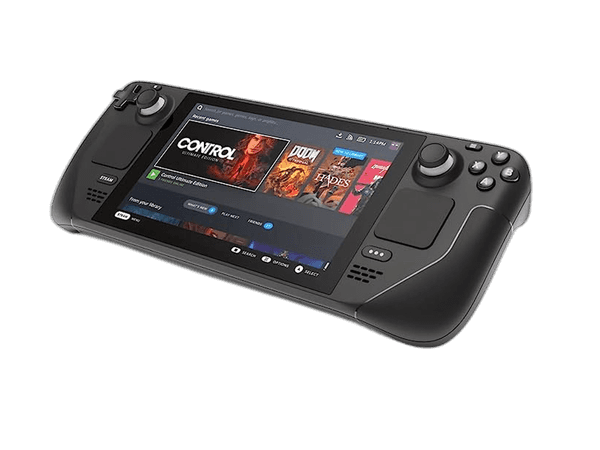Valve's Steam Deck has been making waves in the handheld gaming market, offering a unique blend of portability, performance, and an extensive game library. As an expert product reviewer, I’ve delved deep into the features, benefits, and potential drawbacks of this innovative device. This review will cover everything you need to know about the Steam Deck, from its portability and battery life to its game library, performance, and display quality.
Portability
The Steam Deck is designed with portability in mind, but it’s important to set expectations correctly. Measuring 16.77 x 6.38 x 3.39 inches and weighing 1.47 pounds, it’s larger and heavier than the Nintendo Switch, which might make it less convenient for some users to carry around. However, its size is justified by the powerful hardware it houses.
While the Steam Deck is not as pocket-friendly as some other handheld consoles, it’s still portable enough to be taken on trips, used during commutes, or even played comfortably on the couch. The included carrying case adds a layer of protection, making it easier to transport without worrying about damage.
Pros:
- Powerful hardware in a portable form factor
- Included carrying case for added protection
Cons:
- Larger and heavier than other handheld consoles
Battery Life
Battery life is a critical factor for any handheld device, and the Steam Deck offers a mixed bag in this department. The device is powered by a lithium-ion battery, which is included in the package. Depending on the game and settings, the battery life can range from 2 to 8 hours. For less demanding indie games or older titles, you can expect longer play sessions. However, more graphically intensive games will drain the battery faster.
Valve has made efforts to optimize battery life through software updates and power management settings, but users should be prepared to carry a charger or power bank for extended gaming sessions.
Pros:
- Decent battery life for less demanding games
- Software optimizations to improve battery performance
Cons:
- Shorter battery life for graphically intensive games
Game Library
One of the standout features of the Steam Deck is its access to the vast Steam library. Unlike other handheld consoles that require you to repurchase games, the Steam Deck allows you to bring your existing Steam library with you. This is a significant advantage for gamers who have already invested in a large collection of games on Steam.
The device runs SteamOS 3.0, an Arch-based operating system with a KDE Plasma desktop environment, providing a familiar interface for PC gamers. The Steam Deck also supports cloud saves, allowing you to seamlessly switch between playing on your PC and the handheld device.
Pros:
- Access to the extensive Steam library
- Supports cloud saves for seamless gameplay across devices
Cons:
- Some games may require optimization for handheld play
Performance
The Steam Deck is powered by a custom AMD APU, featuring a Zen 2 CPU with 4 cores and 8 threads, and an RDNA 2 GPU with 8 compute units. This hardware configuration allows the Steam Deck to handle a wide range of games, from indie titles to AAA releases. The device comes with 16 GB of LPDDR5 RAM, ensuring smooth multitasking and performance.
While the Steam Deck is not a replacement for a high-end gaming PC, it offers impressive performance for a handheld device. Games like "The Witcher 3" and "Doom Eternal" run smoothly, albeit at lower settings compared to a desktop PC. The device also supports streaming services like GeForce Now, which can help mitigate performance limitations for more demanding games.
Pros:
- Powerful AMD APU for a handheld device
- Smooth performance for a wide range of games
Cons:
- Not a replacement for a high-end gaming PC
Display Quality
The Steam Deck features a 7-inch LCD screen with a resolution of 1280 x 800 pixels and a 16:10 aspect ratio. The display offers a typical brightness of 400 nits and a refresh rate of 60Hz. While the resolution and brightness are adequate for most games, some users might find the display lacking compared to OLED screens found in other devices.
The anti-glare etched glass on the 512GB model is a nice touch, reducing reflections and improving visibility in bright environments. However, users who prioritize display quality might prefer an OLED screen, which offers better contrast and color reproduction.
Pros:
- 7-inch LCD screen with anti-glare etched glass (512GB model)
- Adequate resolution and brightness for most games
Cons:
- LCD screen may not be as vibrant as OLED displays
Special Features
The Steam Deck comes in three storage options: 64GB eMMC, 256GB NVMe SSD, and 512GB NVMe SSD. The 512GB model also features premium anti-glare etched glass and exclusive virtual keyboard themes. All models include a high-speed microSD card slot for expandable storage.
Valve has also focused on repairability, providing detailed instructions and making replacement parts available. This is a significant advantage for users who want to maintain their device over the long term.
Pros:
- Multiple storage options with expandable microSD slot
- Focus on repairability with available replacement parts
Cons:
- Higher storage models are significantly more expensive
Missing Features
While the Steam Deck is an impressive device, there are a few features that some users might miss:
- No OLED Screen: The LCD screen is adequate, but an OLED option would have been a welcome addition.
- Limited Battery Life: More demanding games can quickly drain the battery, limiting playtime.
- Weight and Size: The device is larger and heavier than other handheld consoles, which might be a drawback for some users.
Conclusion
The Steam Deck is a groundbreaking handheld console that offers a unique blend of portability, performance, and access to a vast game library. While it has some limitations, such as battery life and display quality, its strengths make it a compelling choice for gamers who want to take their Steam library on the go.
For those who prioritize performance and access to a wide range of games, the Steam Deck is an excellent investment. However, users who are looking for a more compact and lightweight device might want to consider other options.
Overall, the Steam Deck sets a new standard for handheld gaming and is a testament to Valve's commitment to innovation in the gaming industry.
Final Rating: 4.4 out of 5 stars
SEO Keywords: Steam Deck review, Valve Steam Deck, handheld gaming console, Steam Deck performance, Steam Deck battery life, Steam Deck game library, Steam Deck display quality, portable gaming device, Steam Deck features, Steam Deck pros and cons




